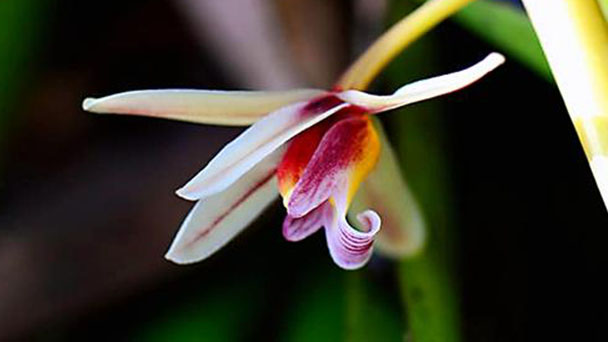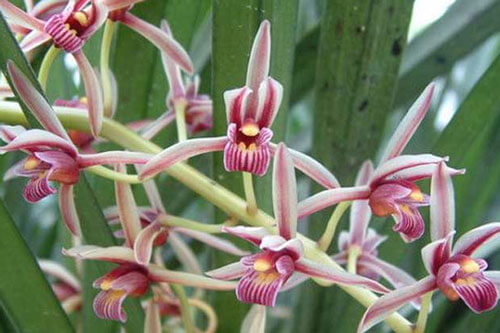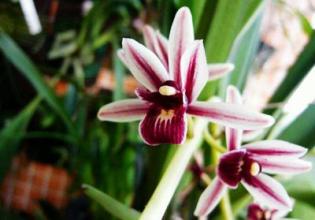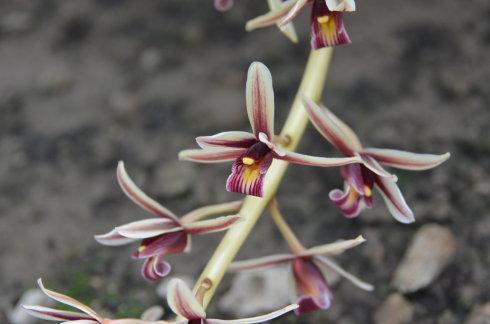Cymbidium Aloifolium Profile
Written by Maggie
Oct 14 2021

Cymbidium Aloifolium is a plant with strong growth and disease resistance, and has high ornamental value. Cymbidium Aloifolium can be used as medicine with whole herbs, and has the efficacy of treating lung heat cough, tuberculosis, pharyngitis, mumps and so on.
Cymbidium Aloifolium picture

Cymbidium Aloifolium Characteristics
Cymbidium Aloifolium Leaf
Cymbidium Aloifolium is an epiphyte. Pseudobulbs are ovoid, 3 -- 6 (-10) cm long, 2.5 -- 4 cm wide, usually enclosed within leaf bases. Cymbidium Aloifolium has 4-5 leaves, band-shaped, thickly leathery, firm, slightly curved, 40-90 cm long, 1.5-4 cm wide, apically 2-lobed or 2-obtuse, joints 8-16 cm from base.
Cymbidium Aloifolium Scapes
Scapes of Cymbidium Aloifolium are protruding from the base of the pseudobulb, pendent, 20 -- 60 cm long; Racemes are with (15-) 20-35 flowers; Bracts are 2-5 mm long; Pedicels and ovaries are 1.2-2 cm long; The flowers of cymbidium aloifolium are slightly smaller and slightly fragrant; Sepals and petals are pale yellow to creamy yellow, central with a chestnut brown band and several stripes, labellum white or cream yellow with dense chestnut brown longitudinal stripes; Sepals of Cymbidium Aloifolium are narrowly oblong to narrowly elliptic, 1.5 -- 2 cm long, 4 -- 6 mm wide;
Cymbidium Aloifolium Petals
The petals of Cymbidium Aloifolium are slightly shorter than the sepals and narrowly elliptic; Lower sepal is subovate, 1.3-2 cm long, 3-lobed, more or less cystic at base, with papillae or villous above; Lateral lobes are above stamen and capsule, middle lobes abs curved; There are 2 longitudinal folds on the labial disc, slightly curved, narrowed or sometimes broken in the middle, and enlarged at the end and base; Stamens of Cymbidium Aloifolium are 1-1.2 cm long, slightly curved forward;
Cymbidium Aloifolium Fruit
The capsules of Cymbidium Aloifolium are oblong-elliptic, 3.5 -- 6.5 cm long and 2 -- 3 cm wide.
Cymbidium Aloifolium blooms in spring, occasionally in autumn.
Cymbidium Aloifolium Habits
Cymbidium Aloifolium generally grows on the mountainside wall of deep mountains and deep valleys, sloping slopes or stone gaps with good water permeability and water retention, beside sparse mountain grasses, and under the shade of secondary miscellaneous wood forests. Or have shade, sunshine time is short or only the place where the star leaks light. Where the air is moist and ventilable, it is sometimes built on the side of mountain streams and cliffs.
Cymbidium Aloifolium are best grown in a well-ventilated environment. Cymbidium Aloifolium likes shade, avoid direct sunlight, like wet, avoid dry, 15℃ to 30℃ most suitable for growth. Poor growth above 35℃.Cold temperature below 5℃ will affect its growth, when the orchid is often in a dormant state. If the temperature is too high and the sun is exposed to the sun, the leaves will burn or scorch in a day or two.If the temperature is too low and does not transfer into the house in time, the phenomenon of frostbite will appear.
Cymbidium Aloifolium is fleshy root, suitable for the use of humus-rich sandy loam, drainage performance must be good, should choose leaf rot soil or humus-containing mountain soil. Slightly acidic loose soil or soil containing iron, pH value of 5.5-6.5 is appropriate.
Cymbidium Aloifolium Care
1. Suitable environment
Cymbidium Aloifolium likes shade, avoid direct sunlight, like wet, avoid dry, 15℃ to 30℃ most suitable for growth. Poor growth above 35℃. Cold temperature below 5℃ will affect its growth, when the orchid is often in a dormant state.
2. Soil care
For sandy loam rich in humus, drainage performance must be good, leaf rot soil or mountain soil with more humus should be selected. Slightly acidic loose soil or soil containing iron, pH value of 5.5-6.5 is appropriate.
3. Lighting care
Cymbidium Aloifolium is a shade-loving flower potted plant, which should not be placed under direct light in daily maintenance and can be properly treated with astigmatism. If the temperature is high in summer, the leaves of Cymbidium Aloifolium will be easily burned or scorched.
It is recommended to preserve Cymbidium Aloifolium in an indoor ventilated place and take it out to the light in the morning.
4. Watering care
Cymbidium Aloifolium prefers wet conditions and is watered sufficiently for such curing, especially during the growing period. Water Cymbidium Aloifolium. In accordance with the principle of thorough watering, water must be thoroughly watered. Never water half of the water.
In addition, watering Cymbidium Aloifolium can be done at the end of the day or in the evening.
5. Fertilization care
Cymbidium Aloifolium needs sufficient nutrients during the growth period, so that Cymbidium Aloifolium can grow vigorously and robust orchid plants. Flanderers can apply rarefied liquid fertilizer every 10-15 days. Mainly to natural organic matter. Natural organic fertilizer nutrient elements are more comprehensive, do not need to apply other fertilizers,
And temperament is peaceful, no side effects on plants, and chemical fertilizer easy to make the substrate hardening, and chemical fertilizer is mostly acid, long-term application, will cause substrate acid, cause disease.

Cymbidium Aloifolium Propagation
Division propagation
In spring and autumn can be carried out Cymbidium Aloifolium division propagation, generally every three years a plant. Any robust plant with dense pseudocorms can be divided, and at least 5 connected pseudocorms should be stored in each cluster after division. Before planting, reduce irrigation water, so that the pot soil is more than. After planting, cover the bottom hole of the pot with broken tiles, then lay coarse stones, which account for 1/5 to 1/4 of the depth of the pot, then put coarse-grained soil and a small amount of fine soil, and then plant with sandy loam rich in humus. Planting depth to the false corm just buried in the soil strength, basin edge left 2 cm along the mouth, covered with Cuiyun grass or fine stones, finally pouring permeable, shady place for 10-15 days, keep the soil moist, gradually reduce watering, normal maintenance.
Seed propagation
The seed of Cymbidium Aloifolium is very thin, and there is only one incomplete embryo in the seed, and its germinating ability is very low. Besides, the seed coat is not easy to absorb water, so it cannot germinate by conventional sowing methods. Therefore, Cymbidium Aloifolium fungus or artificial medium is needed to provide nutrients for germination. Planting fruit had better choose not cracking, surface with 75% alcohol after sterilization, remove the seeds, soaking with 10% sodium hypochlorite for 5-10 minutes, take out three times with sterile water rinse again can play in the cultivation of the bottle containing medium, and dark in the pure, keep temperature 25 ℃ or so, stirring and then moved to the light that can form the original bulb. From sowing to transplanting, it takes half a year to a year. Tissue culture has been successful, and this method can be used to propagate where conditions permit.
Cymbidium Aloifolium Disease Care
Southern blight
Mostly in the rainy season. At the beginning of the disease, the leaf base of Cymbidium Aloifolium is full of white silk, causing root rot. Prevention and control method: remove fungus basin soil, sprinkle on pentachloronitrobenzene powder or lime. Radical cure method: pay attention to ventilation and light, basin soil drainage is good.Severe diseased plants are burned.
Anthrax
It occurs all the year round and is more prevalent in hot and rainy seasons, especially in Cymbidium Aloifolium. The spots first extend from the tip of the leaf to the rhizome, brown at the beginning, and then gradually expand and increase, there are many dry black spots, seriously causing the death of the whole plant. Prevention and control methods: in addition to actively changing environmental conditions, in the onset period, can be used first with 50% methyl tobujin wettable powder 800-1500 times the liquid spray treatment, once every 7-10 days; Then supplemented with 1% equivalent Bordeaux liquid, once every half a month, continuous spray 3-5 times.
Scale insects
Commonly known as "lice". They multiply most quickly in conditions of high temperature, humidity and poor air flow. It can be treated with 1% diethoate oxide or 1500 times 50% mala sulfur spray during incubation period. If the number of pots is not much, it can also be brushed manually.
Cymbidium Aloifolium Distribution
Cymbidium Aloifolium grows in sparse forest or undergrowth on trees or rock walls beside valleys, 100-1100 m.
Cymbidium Aloifolium is cultivated in Guangdong, Guangxi, Guizhou and Yunnan provinces in China, from Sri Lanka in the north to Nepal, and from Indonesia to Java in the east.
Cymbidium Aloifolium Benefits
Cymbidium Aloifolium is a plant with strong growth and disease resistance, and has high ornamental value. Cymbidium Aloifolium can be used as medicine with whole herbs, and has the efficacy of treating lung heat cough, tuberculosis, pharyngitis, mumps and so on.

Latest Updated
- Benefits of Bugleweed - 7 Science-backed Health Benefits
- Bugleweed Dangers & Side Effects - Is It Poisonous?
- How to Plant Evergreen Trees - What You Should Know
- When to Plant Evergreens - Grow Guide for Evergreen Trees
- 12 Wonderful Evergreen Shrubs for Your Garden
- 12 Popular Evergreen Plants with Pictures for Beginners
- When And How To Prune A Lilac Bush Like a Pro
- How to Grow & Care for Lilac Vine (Hardenbergia Violacea)
- Japanese Lilac Tree (Syringa Reticulata) Care & Propagation Guide
- Shumard Oak Pros and Cons - What to Know
Popular Articles
- Winter maintenance of Antirrhinum Majus
- How to Grow Terminalia Mantaly Tree
- How to Grow and Care for Crossostephium Chinense
- How to grow Antirrhinum Majus in spring
- Peristeria Elata (Dove Orchid) Profile: Info & Care Guide
- Underwatered Snake Plant (Sansevieria Trifasciata) - Signs And How To Fix
- How to Care for Brazilian Jasmine Plant (Mandevilla Sanderi)
- How to Grow & Care for Graptopetalum Purple Delight in Summer
- Rosa Chinensis (China Rose): Plant Growing & Care Tips
- How to Care for Baby Sun Rose (Aptenia Cordifolia)